CORNELL HISTORY

In a scene from the 1946 production of "Once Upon a Hill," Cornellians celebrate the first Spring Day, held in 1901. Photo: Division of Rare and Manuscript Collections.
'Once Upon a Hill': Cornell's story, as told by a 1946 student music hall show
The house lights dim in the Willard Straight Theatre – renamed, for this performance, the "W.S. Opera House" – at 8:15 p.m. Friday, April 19, 1946.
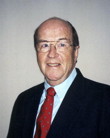
Herbert Hawley '46. Photo: SUNY Geneseo College Communications. See larger image
Placard-wielding actors cross the front of the stage as a piano begins a lively "tramp, tramp, tramp" Civil War-era march. The signs – "Re-elect Honest Abe," "Votes for Women – or Else!" and others – set the year as 1864. As the curtain opens, a spotlight falls on a barbershop quartet of men who begin to sing "Annie Lisle" – a popular ballad of the mid-1800s; its melody would soon be appropriated to become the Cornell alma mater, "Far Above Cayuga's Waters."
This is opening night of "Once Upon a Hill," or, "What Happened to Mr. Cornell's Cow Pasture: A Musical History of Early Cornell," the Cornell Dramatic Club and Cornell Theatre Department's spring 1946 "music hall" show.

Top portion of the original program for the 1946 student production of "Once Upon a Hill" or, "What Happened to Mr. Cornell's Cow Pasture: A Musical History of Early Cornell." Photo: Division of Rare and Manuscript Collections. See larger image
The musical variety show – part vaudeville, part musical and part animated tableaux – was a student-written, student-directed, campy tour of 20 scenes and 15 old-time tunes through the university's earliest days. It covered Ezra Cornell and Andrew Dickson White's first meeting in the New York State Senate in 1864 and the two legislators' subsequent haggling over land-grant funding for a new university; Cornell University's founding; and numerous campus personalities, legends and lore through the first Spring Day in 1901.
The final animated tableau (one of several that closed significant scenes) shows the actors playing Ezra Cornell and A.D. White – now as statues – facing each other across the Arts Quad.
The show, originally scheduled for two performances in April 1946, was such a success that its run was quickly extended; it played to full houses for seven performances over three weekends.
Cast member Herbert Hawley '46, looking back on "Once Upon a Hill" nearly seven decades later, calls the show "a pastiche that was stitched together – it was somewhere between a play, a pageant and a vaudeville act. It had elements of all three." Hawley, curator emeritus of the Stowell-Wiles Art Gallery in Perry, N.Y., played LeRoy Foster, Class of 1872 (who married Emma Sheffield Eastman '73, the university's first woman graduate).
A review in the Cornell Bulletin (the "wartime successor to The Cornell Daily Sun") called "Once Upon a Hill" "a combination of sugar-coated history and schmaltz, with just enough corn to delight the heart of any Cornellian." The Ithaca Journal agreed: "What it lacked in logic of sequence, it made up for in exuberance. … The show is energetic, amusing, apparently quite authentic, and good also, for an evening's fun."
The production's origins
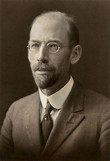
Howard Riley, Class of 1901. See larger image
The idea for the play had its origins in regular Sunday night suppers held at the home of agricultural engineering professor Howard Riley (later of Riley-Robb Hall fame) and his wife, Julia Whiton Mack Riley. Both had grown up in Ithaca and were enthusiastic members of Cornell's Class of 1901. Howard Riley had been a member of the Glee Club and knew all the old Cornell songs. The Rileys also had known Willard Straight (also Class of '01) well.

Priscilla Okie Alexander '45, M.A. '48, and Walt Witcover '44, M.A. '47, the play's co-authors, on Spring Day 1946. Photo: Division of Rare and Manuscript Collections. See larger image
Through conversations with the Rileys in the fall of 1945, Priscilla "Pat" Okie Alexander '45, M.A. '48, who had returned to Cornell for graduate work and rented a room from the Rileys, and two of her housemates, Virginia Genove '48 and Barbara Kenrick '47, heard firsthand stories about early Cornell history.
Drama club members Alexander, Genove and Kenrick talked about the idea for a play or musical based on these early Cornell stories with legendary theater professor Alexander M. Drummond, known affectionately as "The Boss." Drummond encouraged the endeavor and suggested adding contemporary music of the time.
The three women put together the first treatment for a musical show. Even this earliest draft started in the New York State Senate with senators' arguments about how to use the land-grant funds, setting the narrative core of the show at the university's founding and its spirit with the personalities of Cornell and White.
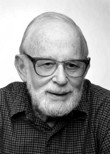
Walt Witcover '44, M.A. '47, in the early 2000s. Photo: Provided. See larger image
Walt Witcover '44, M.A. '47 (then Walter W. Scheinman), a student who had recently returned from wartime service in Europe for graduate courses and who had directed a previous show, got involved. He and Alexander conducted considerable additional research, co-authored the final script and directed the production.
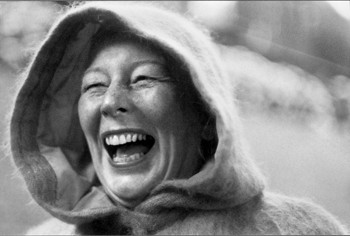
Pat Alexander '45, M.A. '48, in the late 1970s. Photo: Nancy Alexander. See larger image
"I pillaged old songs of the period, and we put together a potpourri of local legends sugarcoating some historical facts," Witcover wrote in his 2011 autobiography, "My Road, Less Traveled."
In 2012, Witcover read the script again for the first time in decades. "The cast [list] brings a lot of old friends back to mind. Some of them are still around," he says. "It holds up … it worked."
Putting it together
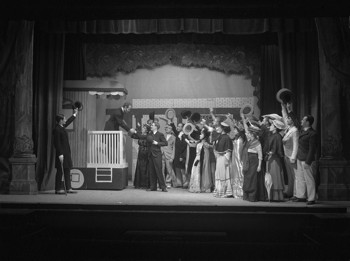
In a scene from "Once Upon a Hill," Cornellians gather at the Lehigh Valley train station to bid farewell to Andrew Dickson White in 1891 as he leaves for Europe. Photo: Division of Rare and Manuscript Collections. See larger image
"We had a lot of fun with tryouts," recalls Alexander, who went on to a career in New York and New England teaching drama, directing and managing community theater productions and writing several historical plays. "Once Upon a Hill" included more than two dozen actors, with many doubling up on parts.
Ezra Cornell was played by Richard Redfern, M.A. '47, Ph.D. '50, a Midwest college teacher and Cornell theater graduate student. "He was the tallest grad student around, so we chose him [as Ezra] partly for that," Alexander says.
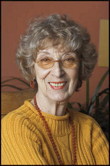
Lenore DeKoven '48. Photo: Provided. See larger image
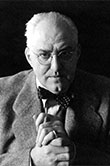
Theater professor Alexander M. Drummond. See larger image
Most roles in the show were either real people from Cornell's history, like Foster and Eastman, or combined character types – such as the play's "demagogue," "clergyman" and yokels "Angus Dangit" and "Jim Aginit." Lea Shampanier Gould '48, M.A. '53, played Eastman. While she says her memories of those days are vague, she "definitely" learned a lot about Cornell history by being in the production.
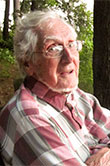
Richard Korf '46, Ph.D. '50." Photo: Mia Korf. See larger image
Witcover, who went on to an accomplished theater directing and teaching career, refers to "Once Upon a Hill" as his first real directing effort.
Lenore DeKoven '48 played the "Lady in Black"; she went on to a career as a director, producer and educator. She still teaches at Witcover's studio in New York. Witcover "was one of these Renaissance men – he came back from the Army [and] got extremely active with his first love, which was the theater," she recalls.
Her role as a widow in black took a satirical poke at the Cornell Widow humor magazine. "The costume was something Madonna might have dreamed up, or Lady Gaga," she says. "It was black, it was sexy, it was boots and a whole headdress."
Richard Korf '46, Ph.D. '50, Cornell professor emeritus of mycology, played "Angus Dangit" in "Once Upon a Hill" (one of his lines: "Humph. Makin' a school outa Ezry's farm.").
"It was just a fun thing to be in," he recalls, noting that his dog also got to be in the show, wearing a Cornell sweater. He also remembers that there was a spittoon sound effect used off stage, which was "used to emphasize some of our comments."
The script blended earnest dialogue, one-liners and inside jokes with songs and colorful scenes from student life. Settings included Cornell's first registration in the downtown Library Hall, the first soiree at the Sage College women's dormitory and the first Cornell crew victory at the Saratoga Regatta in July 1875. Settings included Theodore Zinck's bar, Harry Paris' Shaving Parlor and the Lehigh Valley train station.
Revivals and more
The show was revived in December 1950 as a full production (billed as the "Grand Revival") as part of the celebrations for the 25th anniversary of Willard Straight Hall; Witcover was asked back to direct. It was staged, once more, in shortened form (and with a shorter title: "Once Upon a Hill: A History of Early Cornell") Jan. 11, 1957, for a Founder's Day jubilee in Bailey Hall marking Ezra Cornell's 150th birthday.
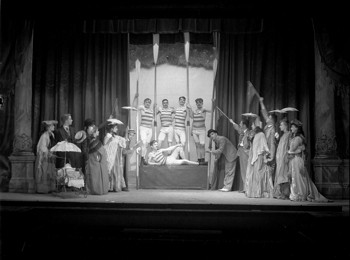
This scene from the 1946 production of "Once Upon a Hill" marks the first Cornell victory at the Saratoga Regatta of July 17, 1875 with the crew present in triumph. Photo: Division of Rare and Manuscript Collections. See larger image
Materials documenting the "Once Upon a Hill" productions reside in Cornell's archive collections. "It was such fun finding the original scripts, music production notes, photographs, programs, correspondence and articles," says University Archivist Elaine Engst. "And we're particularly pleased to now have so many reminiscences from original cast members."
"It's important for students today to know who Ezra Cornell and A.D. White were and the roles they played," says Corey Earle '07, a Cornell history buff and university staffer who also teaches "The First American University," a popular course about the university's history. "The 2015 sesquicentennial is a great opportunity to remind the Cornell community of how unique our alma mater's history is, so it would be wonderful for this play to get a modern revival."
Angela Lu '13 is an ILR student involved in theater who took Earle's course last year. She was not aware of "Once Upon a Hill," but after reading the script, says the production sounds fascinating "because it brings the characters to life."
"The whole desire to connect with those who came before us, to find a sense of heritage among Cornellians – that's what makes this play interesting," she says.
Julia Mack Riley described the impact of "Once Upon a Hill" in her unpublished memoirs, which reside in the university's archives: "This unique production so well portrayed the development of the Cornell idea and its traditions that old Cornellians … were happy at the revival of old emotions, and some of the current undergraduates began to realize the nature of a Cornell spirit about which they had heard through their alumni parents but had never been able to realize."
Today, this little-known production about Cornell's history is part of the university's own history – and is a colorful entry in the story about how Cornellians tell, and have told, the story of Cornell University.
'Once Upon a Hill' potpourri
The show featured lavish costumes, some borrowed from the university's Mrs. Andrew D. White collection of period dresses.
Howard Riley and his wife, Julia Whiton Mack Riley, had been friends and classmates of Willard Straight (Class of 1901); they knew him as "Izzie," which appears as a joke in the script: "Izzie Straight?" It's one of many corny jokes (another: "Y'know, somebody broke into our garden last night, and we had to have him arrested. – Yeah, what was the charge? – Disturbing the peas!")
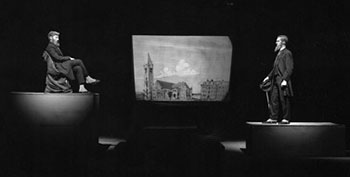
The final animated tableau (one of several that closed significant scenes) in "Once Upon a Hill" shows the actors playing Ezra Cornell and A.D. White - now as statues - facing each other across the Arts Quad. This photo is from the 1950 revival of the production, which used projected backgrounds, and more dramatic lighting, for numerous scenes. Photo: Division of Rare and Manuscript Collections. See larger image
Personalities from early Cornell history were brought to life as characters – not just founder Ezra Cornell and first president Andrew Dickson White, but also Willard Straight, Thomas Frederick "Tee Fee" Crane and "Davy" Hoy.
Songs were taken from hits of the 1860s-1890s and from the "Cornell Song Book," including "Give Us a Drink, Bartender," "Gold Will Buy Most Anything but a True Girl's Heart," "The Bustonian Chorus" and "The Cornell Cheer." The only exception was the "All Round the World, Cornell" song that debuted at the Cornell Masque of 1911. "We liked it, so we put it in anyway at the end," says Pat Okie Alexander '45, M.A. '48.
One scene included a rooster that had been living outside the window of the prop room of the Willard Straight theater, but a barnyard odor rose upward and management complained, Alexander says. Howard Riley "killed it and we ate it at the end of the show's run," she recalls. "There were still some shortages around, and it was nice having the extra meat."
Lea Shampanier Gould '48, M.A. '53, who played Emma Eastman, went on to a long career as an actress; she also is the widow of noted actor Harold Gould, M.A. '48, Ph.D. '53, who died in 2010. The couple returned to the Cornell stage in 1997 to play Willy and Linda Loman in the Schwartz Center production of "Death of a Salesman."